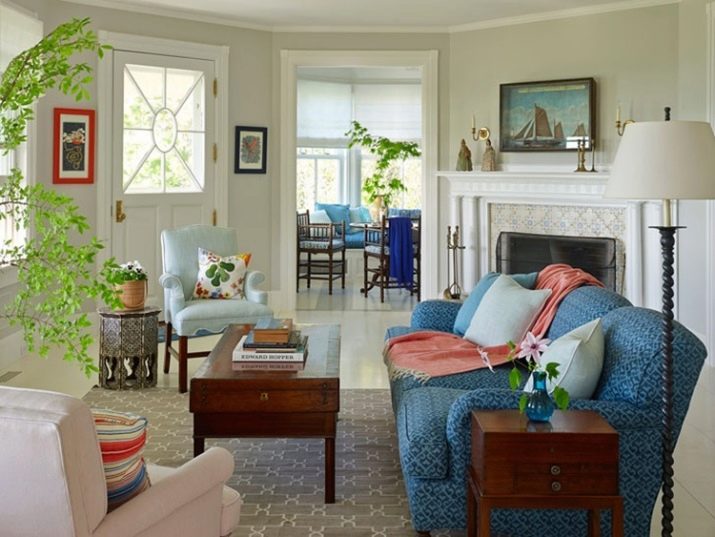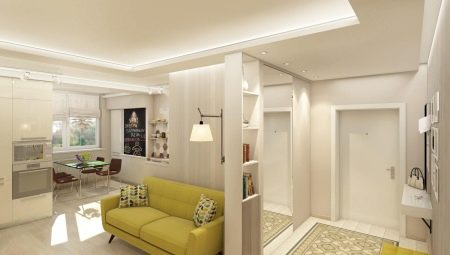The hallway or hall is often called the "small living room", because with sufficient space this room is really able to partially fulfill the functions of a reception room, serve as a place for meeting and seeing off guests. But the typical layout rarely provides for a truly spacious corridor at the entrance to the main part of the house. And yet, the hallway-living room may well appear in the interior of the apartment.
The main thing is to approach the unification of different functional zones in a balanced manner, having previously accurately calculated all the pros and cons of such changes.
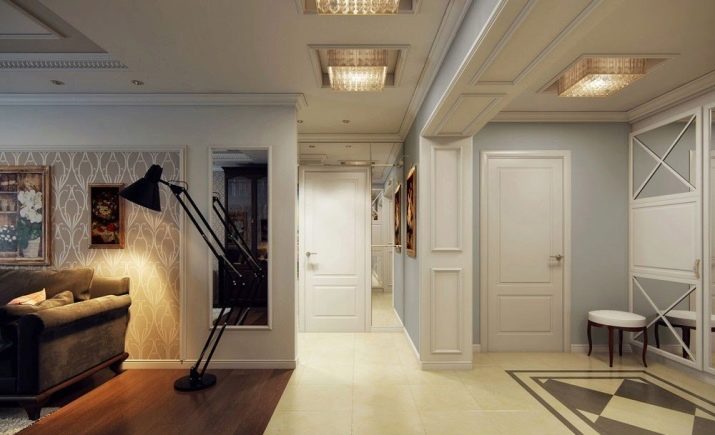
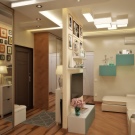
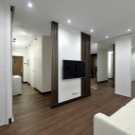

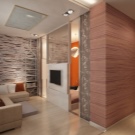
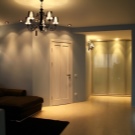
What can the design of a living room combined with a corridor in a private house and apartment look like, which will have to be abandoned in the updated interior, what will be the layout of the hall combined with the entrance hall into one room - before proceeding with the repair, it is worth finding answers to all these questions .
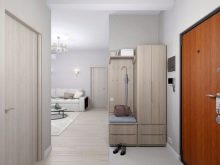
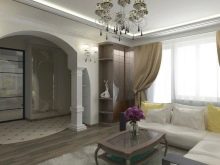

Pros and cons of combining
A modern hallway-living room is not just a hall combined with a corridor or with a kitchen. Such an interior solution in a private house and city apartment gives maximum scope for the complete transformation of typical housing. The area combined in one room is an analogue of a free layout that can be seen in studios. U likeThere are the following advantages to changes.
- Significant increase in usable area. The lack of partitions allows you to implement the most daring design ideas. You can select a recreation area or workspace, zoning a sleeping place.
- Ease of storage planning. For example, corner sliding wardrobes, gaining popularity, are very convenient in the hallway-living room - they save space and allow you to abandon separate wardrobes in each room.
- The increase in light output. The main problem of all the halls is the small amount of natural light penetrating here. Using a joint project, this problem is quite easy to solve, additionally creating the conditions for reducing electricity bills.

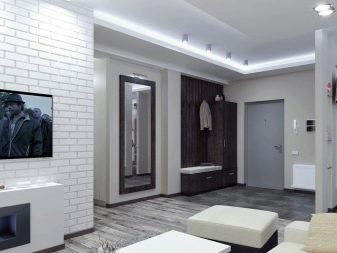
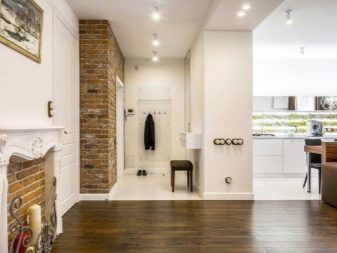

Not without flaws. The connection of the area at the front door with the living quarters mainly creates discomfort due to the proximity to the staircase and staircase. Drafts, unpleasant odors, loud sounds - when demolition of partitions they will be heard much more clearly.
In addition, heat loss will increase, cold air from the entrance will immediately penetrate inside, along with nicotine smoke and other aromas from the stairwell.
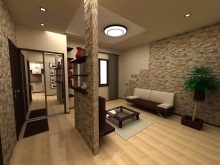
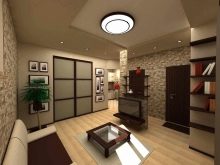
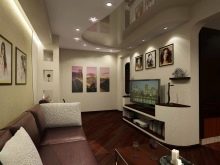
Zoning Options
It is not enough to make a decision to combine the premises in the hallway-living room. It is also important to bring the interior into proper condition, where individual zones will smoothly transition from one to another. If a project without a door implies full integration with the demolition of partitions, various methods of delimiting space can be applied. Among the most popular options, several main ones can be noted.
- Color zoning. The interior design retains a common style and concept, but uses different color schemes. This technique is most easily perceived, does not provide too sharp a distinction and retains the space gained by combining the hallway and the living room.
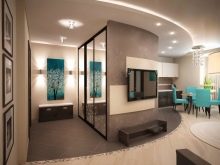


- The use of architectural elements. Forming an arched opening, podium, or complex suspended ceiling with several levels of height is the easiest way to divide the space.
In this way, inside a single room, you can separate the sleeping or dining area, providing a higher level of privacy.
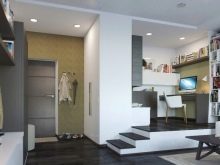
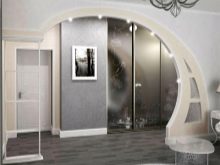
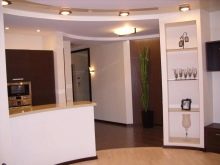
- Zoning with lighting. Lighting design managed to become a separate and very popular direction of decorating residential objects. With the help of properly organized lighting, you can highlight the most significant parts of the premises.
But as an independent method, this method of delimiting the territory is rarely used.
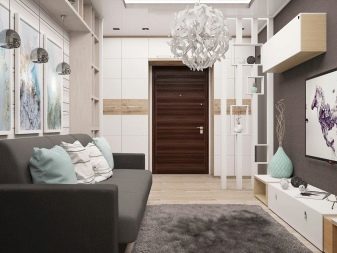
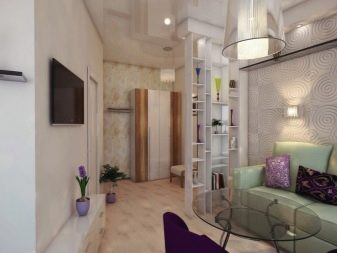
- Zoning furniture and furnishings. If the premises obtained after the merger need to be divided into two parts, conditionally equal in area, you can use screens, racks, sofas, wardrobes and chests of drawers. Paired objects - floor vases, pouffes or armchairs, figurines and art installations also indicate zones well.
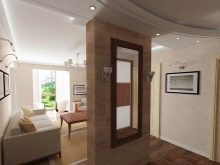
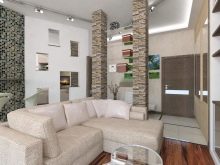
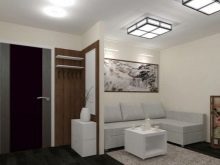
- Use of textiles. Curtains in an impromptu opening, with the right selection of material with expressive color and texture, can be a good addition to the interior decoration. With their help, you can quickly zonate the space or create the illusion of a single room.
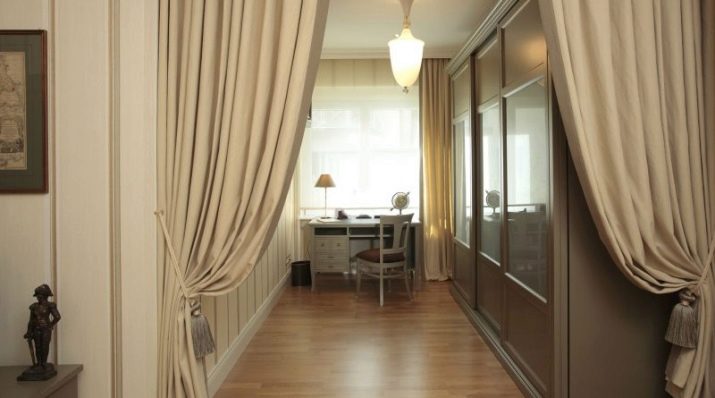
- Mobile partitions. They are built into the opening between the rooms, and move by analogy with the doors of sliding wardrobes. This is convenient if you don’t want to completely sacrifice privacy.
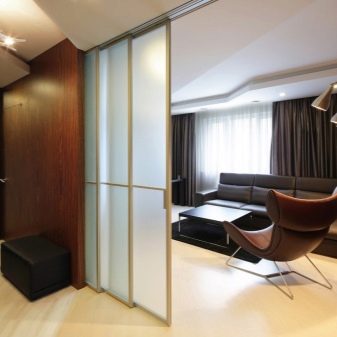
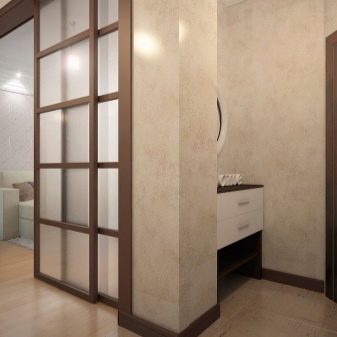
Furniture selection and placement
The free layout of the hallway-living room often causes a desire to fill the formed space with bulky furniture. But here it is better to follow the principles of rational planning. In the room combined with the entrance hall, the organization of the storage system is of the most importance.
In addition, it is recommended to develop a design project in advance that can ensure the correct and convenient arrangement of all the necessary interior items.
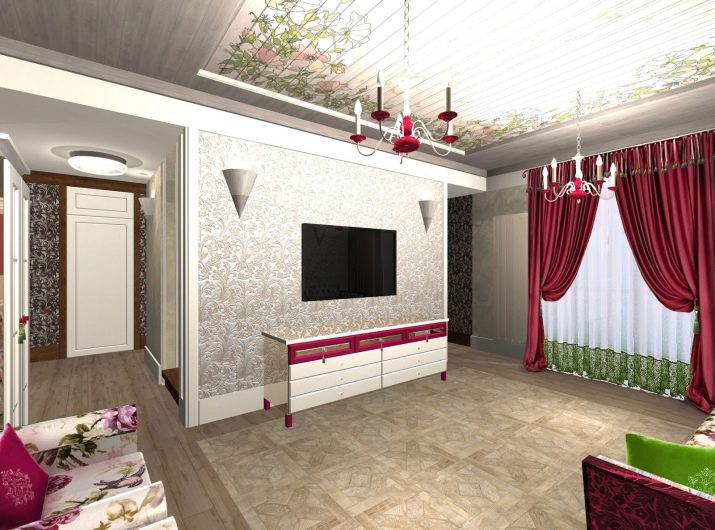

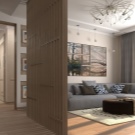

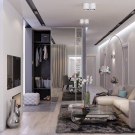
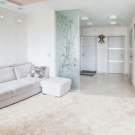
In the space of the hallway-living room, you should abandon chests of drawers and cabinets, as well as other bulky itemslocated not along the walls, but on the aisle. In the area at the door it is worth placing a hanger-rack for hats, gloves, outerwear, a basket for umbrellas. Seasonal items should be put in the wardrobe.
Corner cabinets in this case become a useful acquisition - the built-in design will take up less usable area without losing capacity.


In the interior of the living room area, you can equip a couch with a sofa and armchairs, set a coffee or coffee table, equip an audio system or a games area with a large TV and set-top box, soundbar. If young people live in the apartment, you can equip a bar with a mini-fridge in the living room. If the layout is based on the principle of a studio, it may be necessary to allocate a berth - it can be placed on the podium or in a niche, separated by curtains, a screen from the rest of the room.
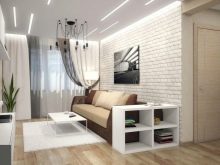
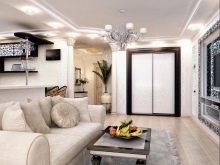
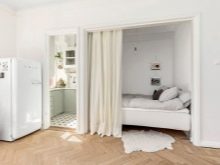
Instead of a wall or single hinged shelves in the living room, it is more rational to use low or high racks. In fact, the main emphasis is on expanding the functionality of the hallway, turning into a cozy lounge, so the furniture of the room can be quite modest. In the hall, it will be appropriate to place a narrow high glove with drawers, soft pouffes, a mirror or a full dressing table. You can use a narrow couch or soft pillows, laid on top of the shoe, as a seat.
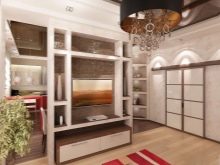
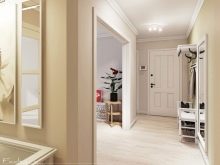
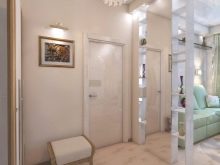
Style solutions
Thinking about what style to choose, and planning a designer renovation in the hallway-living room, first of all, it is worth considering two areas: minimalism and country in all their diversity. Design in a modern style or a light rustic retro can be easily replaced by high-tech or Scandinavian brevity.
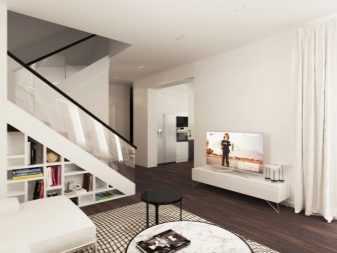

An interesting hallway-living room will look in the following design options.
- English style. It uses classic colors and shades, natural wood, stone. There should be more furniture in such a room than in others. The living area is more pronounced, often includes a dining group.

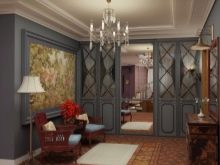

- Scandinavian style. Simple lines, conciseness in detail, gray-white, olive, background colors. Furniture designs are presented by modular and built-in systems. In the living room, the center of the room often remains free. As active accents, bright posters and paintings with an abstract plot are used.

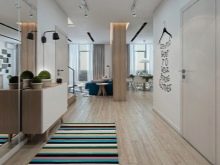
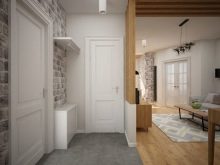
- Classic style. It allows you to give the interior rigor and orderliness. Do not clutter up the space with furniture. As elements of the zoning can be used curtains. It is better to give preference to the traditional gamut of colors - white, black, graphite and pastel shades.

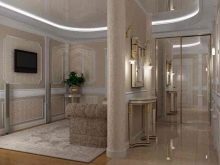
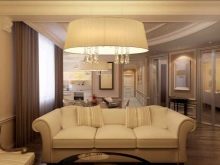
- Loft. Ideally fits into the idea of uncluttered space. A finish that repeats or mimics natural, roughly processed materials is used. Furniture on wheels, glass tables and racks, low sofas will complete the interior decoration.
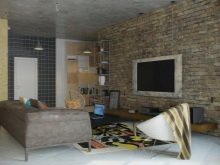
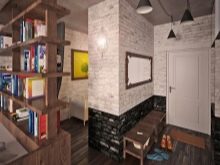
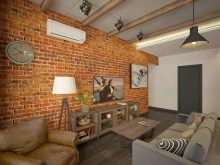
- Fusion A mixture of styles that allows you to harmoniously combine different elements in one interior. With its help, you can fit almost any combination of furniture and decor into the interior.
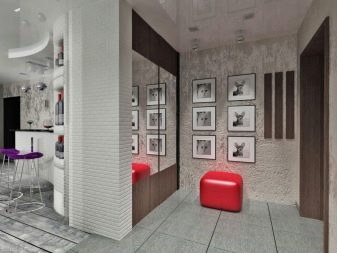
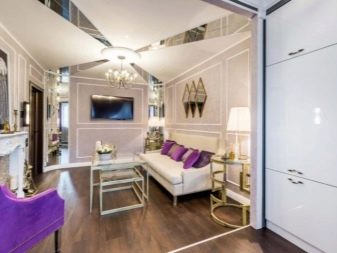
Design Tips
The hallway and living room connected together require special attention to detail in the design of the space. Since one of the rooms is in most cases without a window and burdened by the presence of one or more entrance doors, it is worth paying attention to design options that can level these shortcomings. The following recommendations will be helpful to a beginner decorator.
- When designing the area of the front door, it is better to make it neutral. Optimally, if the color of the finish matches the tone of the floor or is natural, made of wood, or mirrored, creating interesting optical effects.
In a modern interior, polished metal sheets made of stainless alloys can be used.
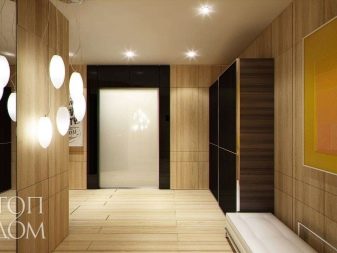

- If the wall between the rooms is partially dismantled, the remaining parts of the structure should be harmoniously integrated into the new interior. On top of the ledge, you can arrange a bar counter or an open rack.On the resulting countertop, with sufficient lighting, indoor plants are located or an aquarium is mounted.
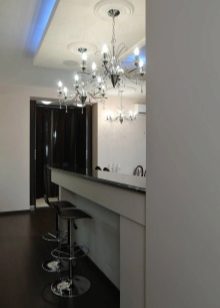
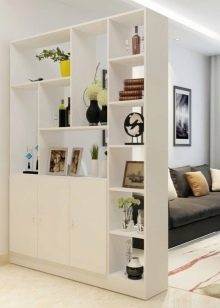
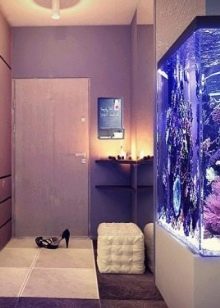
- All temporary partitions should be light, convenient in transportation and storage, mobile. They combine well with the Japanese-style screen-living room hallway or translucent plexiglass inserts recessed into the wall with original decor.
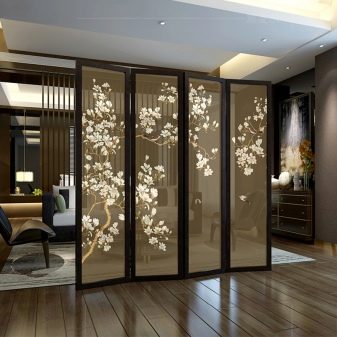
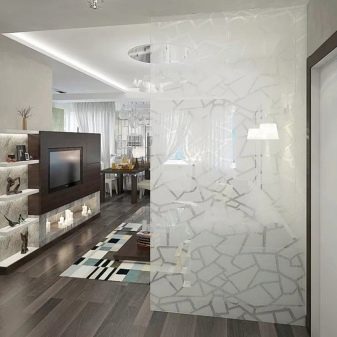
- When choosing a color for walls, avoid repeating the same gamut in different rooms. There should be one bright color accent, it is framed by a neutral background color and two half-tones, which add volume and lightness to the interior.

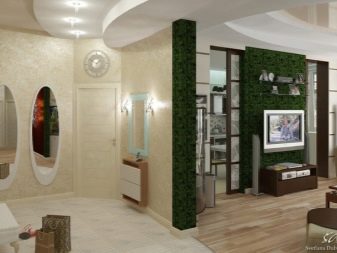
- As a decoration element, it is recommended to use vertical elements. High floor vases, collages from photographs and posters, a fireplace portal or false columns, depending on the chosen style, will allow you to get an interesting design of the space.
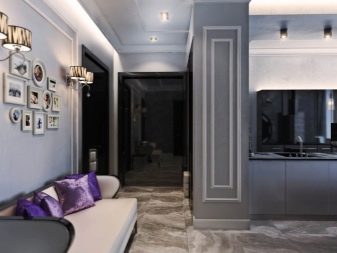
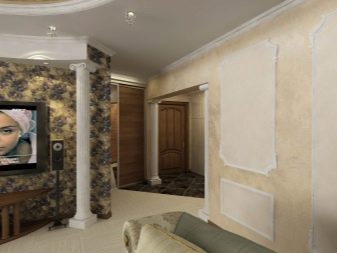
- To avoid the spread of dirt in the living room, special absorbent mats will help to effectively collect dirt and moisture. They have a rubberized, non-slip base, modern design, high absorption capacity.
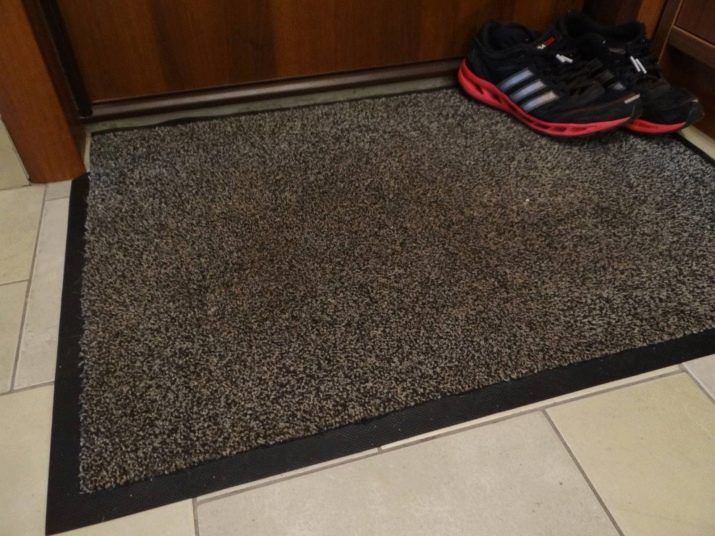
It is worth paying attention to the lighting of the combined hallway-living room. It is better to use only one large chandelier, in the rest of the space there will be enough spots or compact built-in lamps.
Multilevel illumination in the form of sconces and floor lamps will allow you to get a harmonious separation of space.
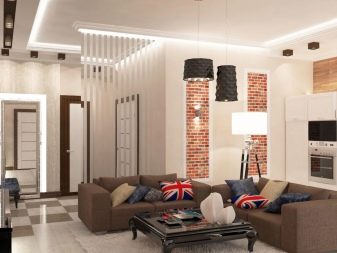
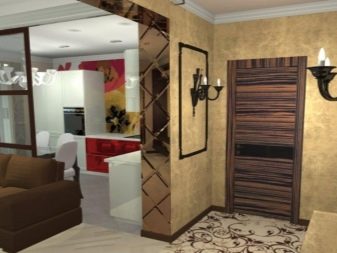
Beautiful examples
- Entrance hall-living room, zoned wardrobe and corner sofa. The space looks stylish without losing its functionality.
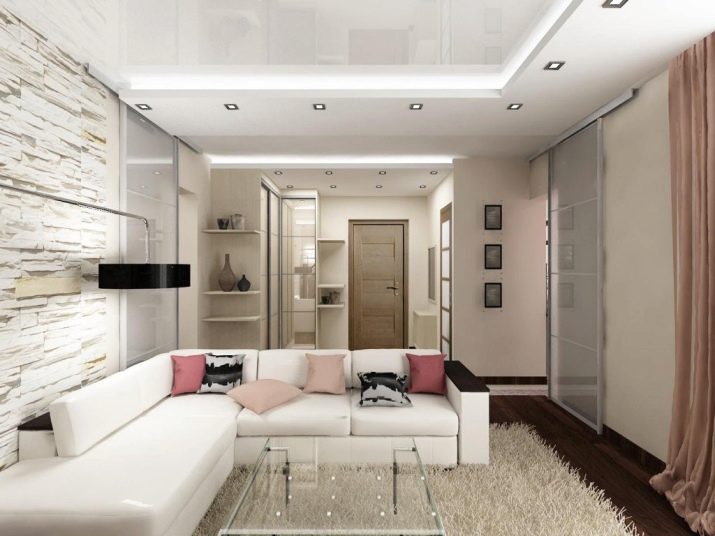
- Entrance hall-living room with harmonious division into zones. The element of demarcation is the finish of the floor and the original partition-column.
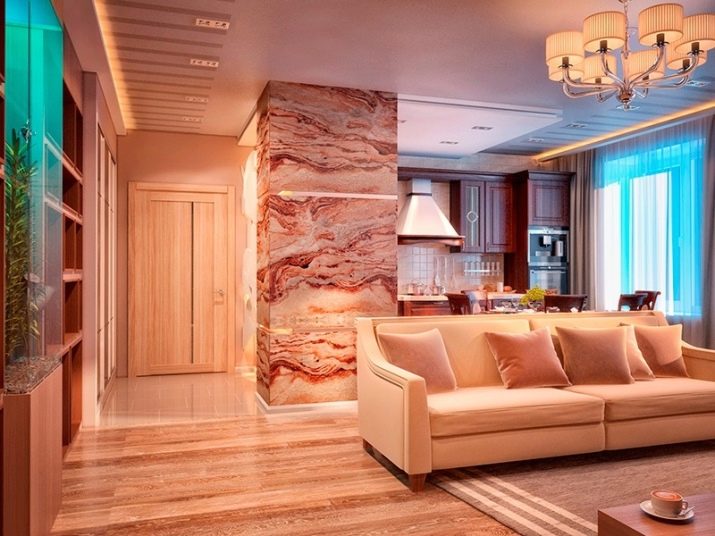
- Hallway-living room in the American style. The front door faces the street, the room has a complex configuration, but does not look cramped.
